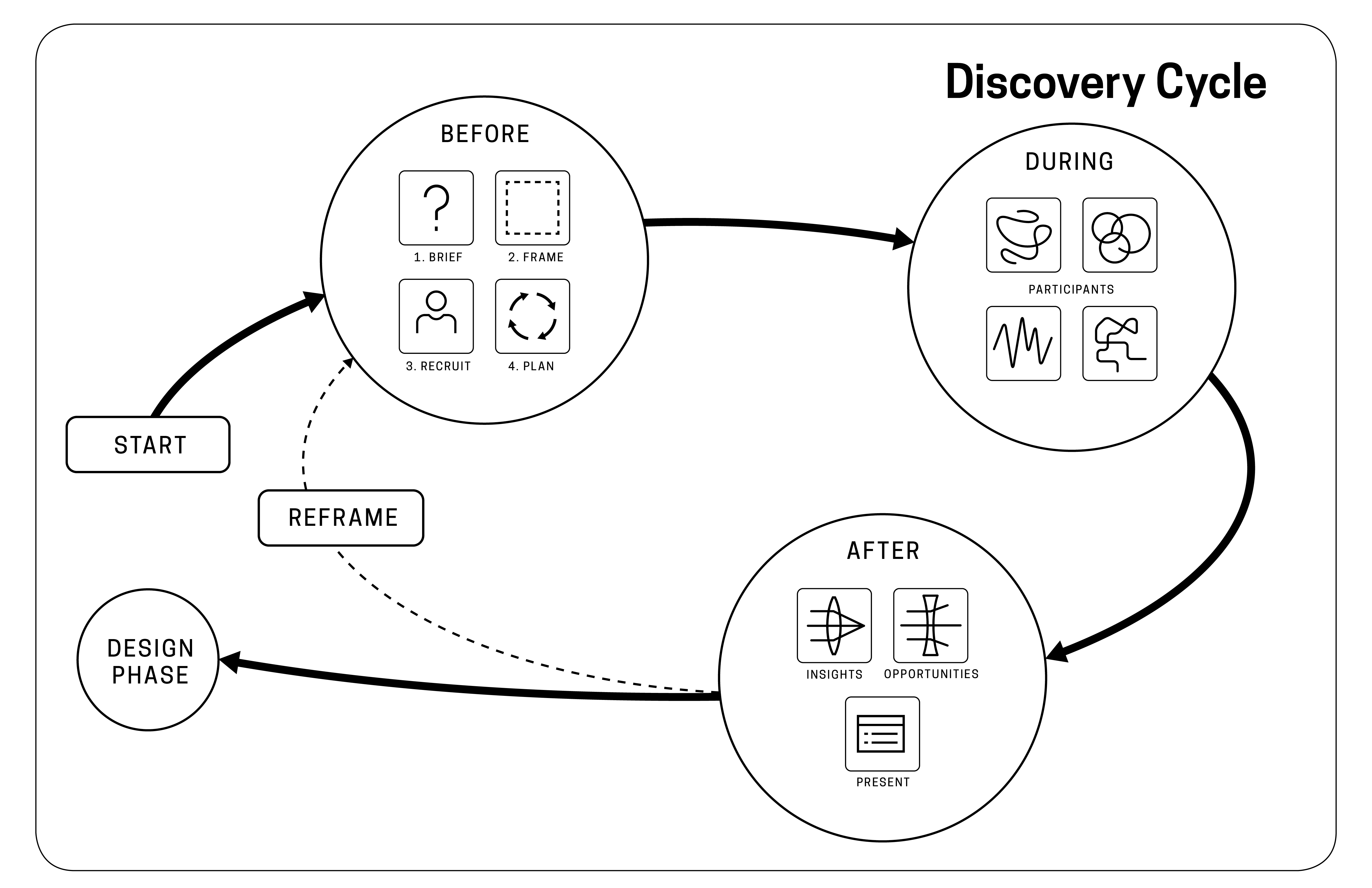Discovery Operations Guide
Discovery Cycle
Discovery Cycle Operations
This Guide covers the operations, or “How-to”, behind a successful discovery cycle. To do this, we focus on providing step-by-step instruction on the concepts outlined in the Discovery Concept Guide. These steps include understanding your project’s practical scale, the teammates and roles required, setting up for research, keeping good records of your data, how to synthesize as a team, and communicating your findings.
We can use the illustration below to think about the Discovery process along a timeline.
Discovery Cycle: Operational timeline
This visualization illustrates how the HCD process requires many operational steps, some of which overlap in time. This means that you and your team cannot work individually without coordination or looking to the next step, nor can you try to accomplish one step before starting another.
Each step of a Human-Centered Design Discovery project differs in three basic ways:
- The amount of time a step might take to complete
- The amount of internal, team, or individual work versus external, organizational, or public work it will require
- The level of coordination and overlap between steps that you and your team can expect.
Outline of Operational Steps
Project Framing is a deeply internal step. Sometimes Leadership will be deeply invested during Project Framing; if not, update them and get sign-off on the project frame once you have articulated it.
Simultaneous to finishing Project Framing and starting high-level logistics planning in Planning 1, build your team. It’s important to have a well-rounded team bringing complementary skills.
Leadership Buy-In is a second touch to leadership to ensure the final go-ahead for your project. Details regarding manpower and travel should get clearance in this phase.
Planning 2 means logistics; it can be stressful as it runs partially in tandem to Recruiting and sometimes Research which are both external-facing. Making public your project can cause anxiety, but if you have it well-framed and are willing and able to discuss your work clearly and succinctly, people will be interested.
Inevitably when working with many people and their competing schedules, it’s essential to keep both a detailed and a bird’s-eye view on both the overall project schedule and your team members’ schedules. This can be challenging in the rush of gathering and tracking Research, but it’s crucial to keep focused at this time.
Immediately after Research wraps up, Synthesis, begins. Expect Synthesis to be deep mental work. This is one of the most difficult and tiring parts of the project, but this is where you will see your research come together in patterns. Ensure that you do not lose the momentum of research by scheduling the Synthesis sessions for as few days as possible after the end of the Research phase.
Finally, Communication is where you take your discoveries to your stakeholders. This is a crucial piece of the project. If you do not communicate well, then your research, and all your work, could be lost. Be sure to prepare, practice, and follow up on your presentations. Your work deserves it.
Discovery Cycle Concept
The concepts, or “Why?”, behind the discovery cycle is covered most extensively in the HCD Discovery Concept Guide. We’ll link to the Discovery Concept Guide throughout this Operations Guide in order to provide the why behind the how-to instructions that are upcoming.

Brief Concept: What is Discovery?
When designers say “discovery”, they’re talking about research. This research can take many forms, but it always includes both secondary or desk research, which means reading white papers and articles on the subject, and primary research, meaning research with the people who are involved in the team’s subject matter.
Brief Context: The Discovery Cycle
Human-Centered Design Discovery should be thought of as a cycle, instead of a linear process. This is because after completing research rounds, frequently one of two things happens after a research phase is completed:
- The team finds new research as well as design opportunities to follow.
- The team finds that the problem that they were investigating was slightly off-target. The research frame needs to be adjusted and discovery should start again.
